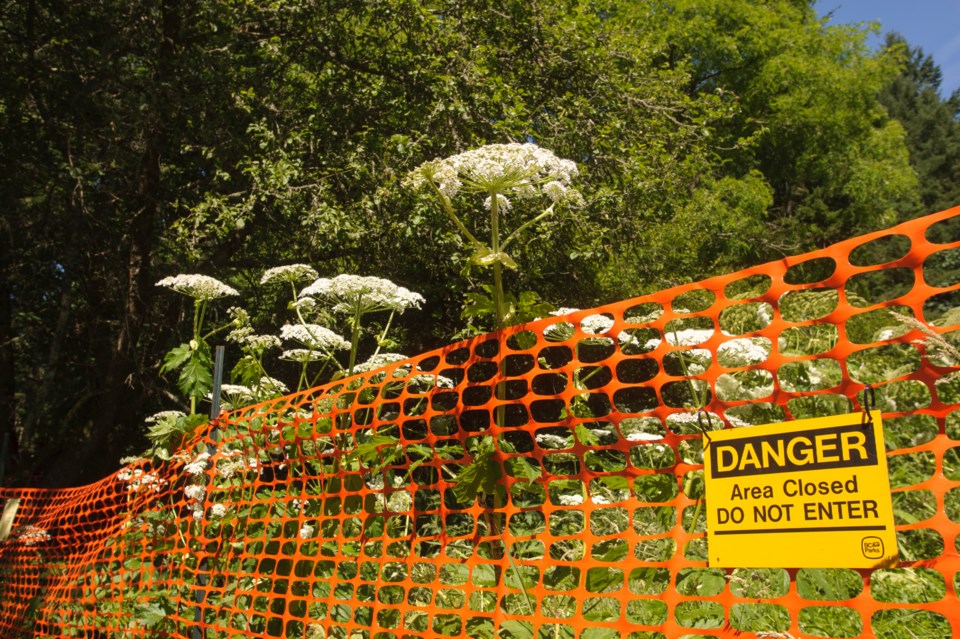While Ontario is known for its stunning landscapes and lush vegetation, it is unfortunately harbouring one of Canada’s most dangerous plants: Giant Hogweed.
Towering to heights up to six metres and crowned with delicate white flowers, this plant may initially appear innocent and beautiful, but this invasive species poses significant health risks if encountered.

The dangers of Giant Hogweed
The dangers of Giant Hogweed stems from its phototoxic sap, which contains furanocoumarins—a group of chemicals that can cause severe skin reactions when exposed to sunlight. Contact with the sap, followed by exposure to ultraviolet (UV) radiation from sunlight, triggers a condition known as phytophotodermatitis. This reaction can lead to painful and potentially long-lasting skin damage.
In some cases, exposure to Giant Hogweed has resulted in hospitalization due to severe burns.
If you mistakenly brush against a Giant Hogweed and the sap comes into contact with your skin, be mindful of these symptoms:
Redness
Affected areas may develop a reddish rash, which can be painful and itchy.
Blisters
Blistering can occur within 24 to 48 hours after contact, and these blisters can be large and filled with fluid.
Burns
The skin may develop burns, similar to those caused by exposure to heat.

Eye contact with the sap has been reported (in the media and by various web sites) to cause temporary or permanent blindness. However, evidence of permanent blindness linked to exposure to Giant hogweed cannot be substantiated by any existing research.
What should you do if you come into contact with Giant Hogweed?
According to the Ontario’s Ministry of Natural Resources website, if you come into contact with Giant Hogweed and get sap on your skin, wash the area thoroughly with soap and water. Seek medical advice if phytophotodermatitis occurs or if you are unsure about the extent of your exposure.
If you get sap in your eye, flush your eye with water immediately and see a doctor immediately.
After exposure, you should also consider:
Avoiding sunlight
As soon as you come into contact with the plant, immediately move away from sunlight or any other sources of UV radiation. Find shade or go indoors to limit the impact of sunlight on your skin.
Covering up
Once you have washed the area, cover it with clothing or a bandage to protect it from further exposure to sunlight.
Giant Hogweed removal
If you have Giant Hogweed on your property, it’s recommended that you hire a professional exterminator to safely remove it, preventing the spread of seeds. The best time to remove Giant Hogweed is late April or early May.
Giant hogweed has the potential to spread readily and grows along roadsides, ditches and streams. It invades old fields and native habitats such as open woodlands.
If you think you have Giant hogweed on your property or if you see it in your community please call the Invading Species Hotline at 1-800-563-7711 or report your sighting online. You will be asked to send in photos for identification. Do not collect parts of the plant for identification.
Looking for an easy way to identify which plants are invasive or dangerous? Here is the best plant identification app according to Wirecutter:
PlantNet
If you want an app that quickly and accurately identifies various plants, Wirecutter recommends PlantNet Plant Identification. The app is a favourite among plant enthusiasts and general interest users due to its simplicity - PlantNet is not "consumed with ads or sneaky pop-ups that trick you into paying for extra features."

You can download the PlantNet app for Android or iOS.
Honourable mention: iNaturalist
Along with identifying plants, iNaturalist offers a social element, allowing users to share and confirm plant findings with other users. The app is geared toward amateur and professional naturalists, scientists and educators.
Like PlantNet, iNaturalists available on Android and iOS and is free to download. One flaw, Wirecutter points out, is that app wasn't quite as accurate and not as straightforward to use.





